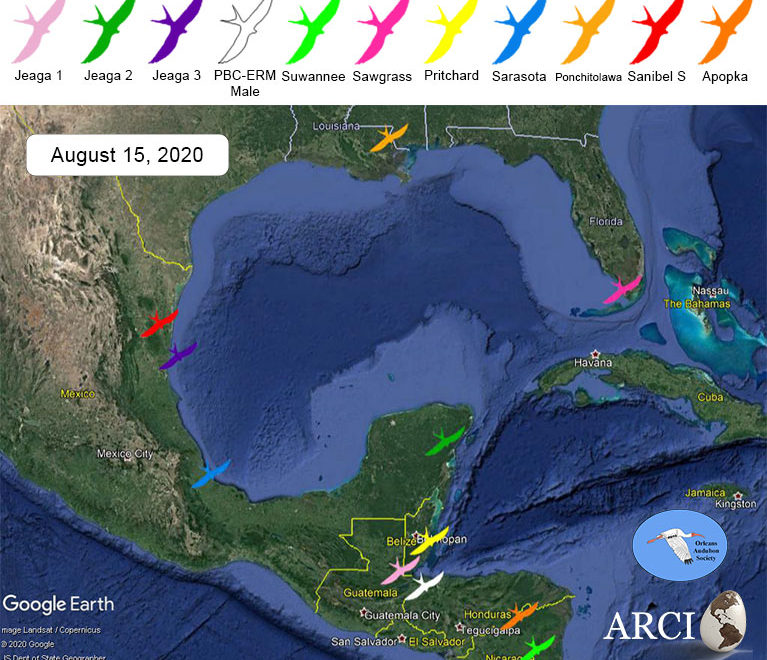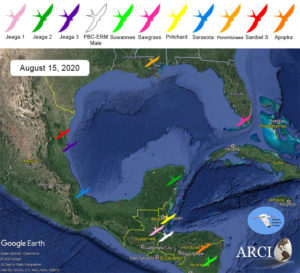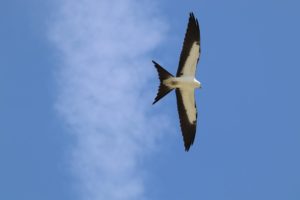Since we last wrote, we watched three GPS-tracked Swallow-tailed Kites head out over the Gulf of Mexico. So far, only two of them, Jeaga 1 and Sarasota, have made it safely to a shoreline.
Jeaga 1, last over open ocean south of the Cayman Islands, made landfall south of Placencia, Belize, and has been spending her stop-over time ranging throughout the Toledo District of Belize.
Sarasota was pushed westward by tailwinds into the central Gulf but thankfully made landfall just north of Tampico, Mexico and continued to follow the Gulf coast south where he’s taking his time just south of the famous Veracruz hawk-watch location.
The good news for Jeaga 3 is that her GSM-GPS tracking unit produced excellent movement data after leaving Cuba. Unfortunately, 2 days later, she was still out over the Gulf of Mexico. Winds had derailed her southwestward flight to the Yucatan Peninsula, pushing her westward instead along a track very similar to those of Sanibel South and Sarasota. Two days after leaving Cuba, within 7 miles of the Mexican coastline just north of Tampico, Jeaga 3’s on-board “cell phone” connected with a land-based tower and uploaded her accumulated GPS data. At this point, she already had turned north, then northeast, and eventually back to the east, thus heading back out over the open waters of the Gulf of Mexico. She had been so close to land, but was now flying the WRONG way!
It might be helpful here to review some details about the solar-powered GSM/GPS transmitters these Swallow-tailed Kites are carrying. The GPS component of these solar-powered tracking devices are programmed to collect a highly accurate location fix (latitude x longitude accurate with 10 to 15 meters) every hour. This acquisition process, dependent on satellite communications just like any earth-bound GPS receiver (including the one that plots a moving map on your phone as you drive down the road), runs continuously regardless of where the bird is, even when far from a cell-phone tower. Months-worth of GPS fixes can be stored onboard. However, because the transmitter component of these devices communicates with international cellular phone networks, it is unable to upload the stored GPS data until the bird happens to fly within cell-tower range. Therefore, we may go for long periods not “hearing” from birds as they migrate over ocean and through remote areas. If something goes wrong during these times and the data-stream ceases, we have no way of knowing what happened. Some of the Swallow-tailed Kites we have tagged remain beyond tracking range for their entire wintering period, and we must wait in anticipation for their radios to resume transmission once they have begun migrating northward. Fortunately, once this happens, we receive all of the GPS fixes that have been received and stored while the transmitter has been silent. We are still hopeful that Jeaga 3 has made it to land, just beyond cell-tower range, and may soon begin uploading her stored GPS locations.
As of August 15th, 2020, all but two of the 11 GPS-tagged Swallow-tailed Kites have left the U.S.A.
Ponchitolawa, tagged by colleague Dr. Jennifer Coulson of Orleans Audubon, still resides on the Pearl River in Louisiana, still fueling up for the migration ahead.
Sawgrass from Pinellas County, Florida, is now on the southern tip of Florida, about to cross the Gulf of Mexico.
Once Apopka was ready to start southward from his St. Johns River pre-migration location, he spent a night in the Okaloacoochee Slough State Forest, flew over the Florida Keys the next day, then crossed the Straits of Florida to Cuba. After a night in near Havana, he headed due south, skipping Mexico’s Yucatan Peninsula altogether and making it all the way to Honduras! He must have well-prepared for this ~570-mile over-water flight because he kept moving south once over land.
Sanibel South made her way to the Gulf coast of Mexico and is following the path taken by Sarasota, now 400 miles farther south.
Suwannee and PBC-ERM male experienced what we would consider an ideal safe migration with quick flights to western Cuba, one night on Cuba, and west over water from the Guanahacabibes Peninsula the next day. With a two-hour lead, Suwannee spent a night south of Tulum, Mexico, while PBC-ERM had made it to the island of Cozumel, Mexico for the night. Neither wasted time once on land. PBC-ERM male is in Guatemala, and Suwannee is 300 miles ahead in Nicaragua.
After a night in Highlands County, Florida, Prichard crossed the Gulf of Mexico directly to the Yucatan Peninsula on 9 August, the fastest GPS track across open ocean for any of this year’s migrating kites.
Sending good vibes to our missing Jeaga 3, hoping that she is safe on land. Check back with us next week and we’ll bring you up to date.
As always, we are grateful to all the organizations and individuals who have made ARCI’s long-term studies of Swallow-tailed Kites possible, thus helping us understand how these amazing birds need our help. The ever-growing list of current contributors includes:
Audubon Center for Birds of Prey
bioGraphic
Caloosa Bird Club
Clearwater Audubon Society
CROW – Clinic for the Rehabilitation of Wildlife, Inc.
Florida Panther National Wildlife Refuge
Friends of Palmetto Bluff Conservancy
Friends of the Carlton Reserve
Friends of the Florida Panther Refuge
Friends of the Lower Suwannee & Cedar Keys National Wildlife Refuges
Halifax River Audubon
Jacksonville Zoo and Gardens
Lower Suwannee National Wildlife Refuge
National Audubon Society
Oklawaha Valley Audubon Society
Orange Audubon Society
Orleans Audubon Society
Palm Beach County Department of Environmental Resources Management
Palm Beach Zoo and Conservation Society
Palmetto Bluff Conservancy
Peace River Audubon Society
Sanibel-Captiva Audubon Society




Leave a Reply